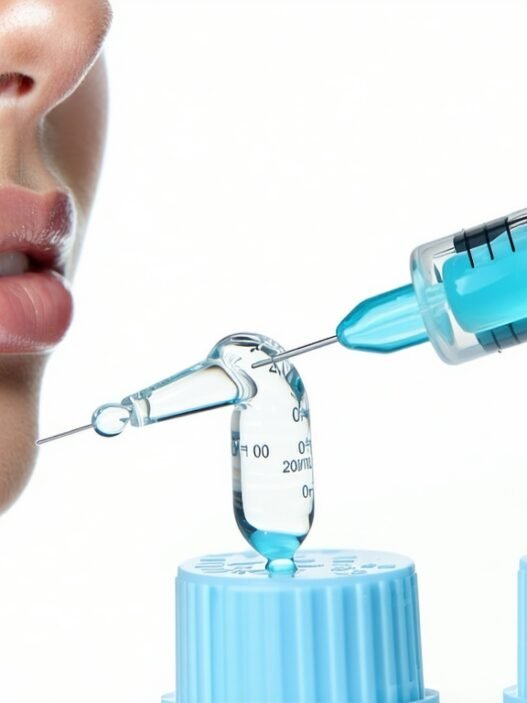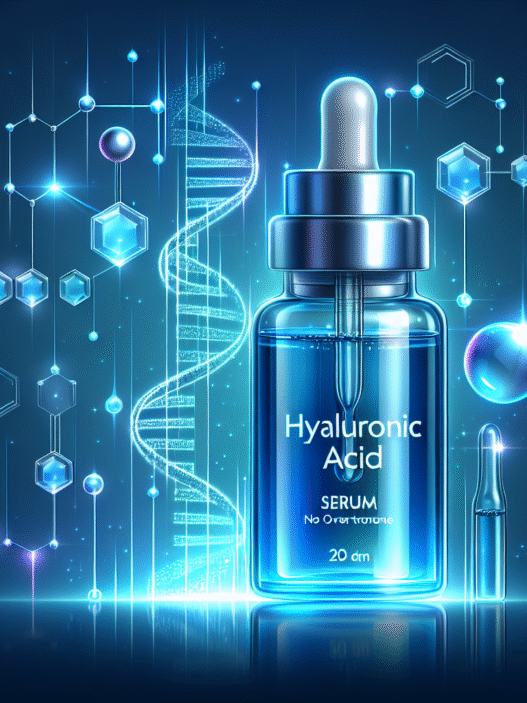Understanding Hyaluronic Acid
Introduction to Hyaluronic Acid
Hyaluronic Acid (HA) is a naturally occurring substance found within the human body, predominantly in the skin, connective tissues, and cartilage. It plays a vital role in maintaining hydration and elasticity in the skin. Remarkably, the skin contains approximately 50% of the total body’s hyaluronic acid PubMed Central.
Understanding HA’s function is crucial for those interested in anti-aging treatments and skincare. It has a unique ability to bind and retain water molecules in the skin, helping to provide a plump and youthful appearance.
The degradation of HA is mainly facilitated by enzymes known as hyaluronidases, which break down HA into smaller fragments. This process can contribute to the loss of moisture in the skin, especially as we age PubMed Central.
Importance in Skincare
In the realm of skincare, hyaluronic acid is a key component for maintaining skin moisture and supporting overall skin health. Its moisture-retaining properties help combat skin dryness and enhance skin texture. As skin ages, the depletion of HA in the epidermis leads to a reduction in the skin’s natural moisture levels, resulting in dryness and the appearance of fine lines and wrinkles PubMed Central.
Key benefits of hyaluronic acid in skincare include:
| Benefit | Description |
|---|---|
| Hydration | Retains moisture, keeping the skin supple and hydrated. |
| Elasticity | Improves skin elasticity, reducing the appearance of fine lines. |
| Healing | Aids in skin repair and regeneration, promoting a healthy complexion. |
Beauty enthusiasts often seek out products containing HA for its anti-aging benefits. However, it is essential to be aware of how to use it effectively and consider what products may not pair well with it. For more information on the intersection of hyaluronic acid with other ingredients, read about what not to mix with hyaluronic acid?.
While hyaluronic acid is celebrated for its benefits, one should also consider the potential downsides, including the question of what are the disadvantages of hyaluronic?. For anyone interested in skin health, understanding the comprehensive role of hyaluronic acid can significantly impact their skincare routine.
Safety of Hyaluronic Acid
Hyaluronic acid is widely used in skincare and medical applications, but potential side effects and allergic reactions must be understood. This section examines the common side effects associated with hyaluronic acid and the risks of allergic reactions.
Side Effects of Hyaluronic Acid
While hyaluronic acid products are generally regarded as safe, they may produce adverse effects in certain individuals. Specifically, people who receive injections containing hyaluronic acid may experience side effects such as swelling, pain, redness, bruising, or itching. These symptoms typically resolve within a week. In rare cases, more severe side effects like infection or tissue necrosis may occur, which require medical intervention.
| Side Effect | Description | Duration |
|---|---|---|
| Swelling | Localized puffiness at the injection site | Usually resolves in 1 week |
| Pain | Mild discomfort during or after injection | Temporary, up to 1 week |
| Redness | Skin may appear red and inflamed | Typically resolves in a few days |
| Bruising | Bruise formation at the injection area | Can last several days |
| Itching | Light irritation around the treated area | Temporary, resolves quickly |
| Severe Effects | Possible infection, tissue necrosis | Requires immediate medical care |
Allergic Reactions to Hyaluronic Acid
Individuals with a history of severe allergic reactions should approach products containing hyaluronic acid with caution. Although allergic reactions are rare, they can occasionally occur. Symptoms of an allergic reaction may include hives, difficulty breathing, or swelling of the face, lips, tongue, or throat. Patch testing is recommended prior to the use of new skincare products containing hyaluronic acid to identify any potential reactions (Medical News Today).
For those with specific health concerns, it’s advisable to consult a healthcare professional, especially during pregnancy or breastfeeding when the safety of hyaluronic acid in these stages has not been established.
Overall, while hyaluronic acid is commonly seen as beneficial for skin health, understanding the potential side effects and managing allergies is vital for safe usage. Those interested in further understanding the benefits of hyaluronic acid can check out what does hyaluronic acid do to your skin?.
Risks and Complications
When considering the use of hyaluronic acid in various applications, it is crucial to be aware of the potential risks and complications. Despite its popularity in skincare and medical treatments, there are disadvantages to using hyaluronic acid that enthusiasts should take into account.
Severe Side Effects of Hyaluronic Acid
While hyaluronic acid products are generally considered safe, they may still produce adverse side effects, particularly when injected. Common side effects include swelling, pain, redness, bruising, or itching. These effects typically resolve within a week. However, in rare instances, individuals may experience severe side effects such as infection or tissue necrosis, which can require medical intervention (Medical News Today).
Common Side Effects
| Side Effect | Duration |
|---|---|
| Swelling | Up to 1 week |
| Pain | Up to 1 week |
| Redness | Up to 1 week |
| Bruising | Up to 1 week |
| Itching | Up to 1 week |
Complications from Injections
Complications arising from hyaluronic acid injections can pose serious health risks. Inappropriate administration can lead to issues such as severe allergic reactions, vascular occlusion, or improper placement, which can result in disfigurement or the need for corrective procedures. Ensuring that injections are performed by a licensed, qualified medical professional is vital for minimizing these risks (Cleveland Clinic).
In rare cases, improper use can lead to severe complications, including infection or necrosis of the tissue. This underscores the importance of following the prescribed guidelines for injectable hyaluronic acid and being cautious about where and how it is administered. Always consult with a healthcare provider before undergoing any treatment involving hyaluronic acid to assess individual risk and safety (Cleveland Clinic).
Though hyaluronic acid is beneficial for hydration and anti-aging, understanding the potential risks and complications is essential for beauty and skincare enthusiasts. For further reading, consider exploring what does hyaluronic acid do to your skin? and what happens if you use too much hyaluronic acid on your face?.
Hyaluronic Acid in Medical Use
Hyaluronic acid has various applications in the medical field, particularly for treating joint issues and enhancing skin health. Understanding its FDA approval and guidelines, as well as safety considerations, is crucial.
FDA Approval and Guidelines
The FDA has approved hyaluronic acid injections primarily for individuals suffering from knee pain due to mild to moderate osteoarthritis when other treatments have proven ineffective. These injections work to provide relief by lubricating the joint, effectively easing discomfort. However, guidelines explicitly advise against the use of hyaluronic acid injections for treating hip osteoarthritis.
It is important to note that any hyaluronic acid injections must be administered by a licensed and qualified medical professional to ensure safety and effectiveness. Adhering to prescribed methods is also vital for optimal results in treatment.
| Treatment | FDA Approval Status |
|---|---|
| Hyaluronic Acid Injections for Knee Pain | Approved |
| Hyaluronic Acid Injections for Hip Osteoarthritis | Not Recommended |
Safety Considerations for Medical Applications
The average adult weighing 70 kg (150 lb) contains approximately 15 grams of hyaluronan, with one third being broken down and synthesized each day (Wikipedia). For those considering hyaluronic acid treatments, it is essential to use prescription products as directed by a healthcare provider.
While over-the-counter hyaluronic acid products like serums, creams, and eye care solutions are generally recognized as safe, any injection treatments come with potential risks. Common side effects following injections may include local swelling and pain, which are typically temporary.
Additionally, it is crucial for patients to discuss their medical history and any ongoing treatments with their healthcare provider before starting a hyaluronic acid regimen to minimize complications. For a deeper insight into how hyaluronic acid impacts the skin, refer to our article on what does hyaluronic acid do to your skin?.
In summary, while hyaluronic acid presents advantageous uses in medical settings, understanding FDA guidelines and safety considerations is essential for those looking to incorporate it into their treatment plans.
Hyaluronic Acid in Cosmetic Use
Hyaluronic acid has gained immense popularity in the beauty industry for its hydrating properties and benefits for skin health. It is widely found in various skin and beauty products, as well as in dermal fillers that enhance facial aesthetics.
Skin and Beauty Products
In the realm of skincare, hyaluronic acid is commonly used in serums, creams, and lotions. Its ability to retain moisture makes it a favorite for maintaining skin hydration, which is essential for a youthful appearance. Over-the-counter hyaluronic acid products applied topically are generally considered safe for most users (Cleveland Clinic). However, combining hyaluronic acid with other medications or compounds may have some risks of side effects.
Here are some popular types of skin and beauty products containing hyaluronic acid:
| Product Type | Common Use |
|---|---|
| Serums | Deep hydration |
| Creams | Moisture retention |
| Lotions | Daily skin nourishment |
| Eye Care Products | Hydration and puffiness reduction |
Although safe for most, users should be cautious and follow guidelines, especially when using products that contain multiple active ingredients. For further information on interactions, check our article on what not to mix with hyaluronic acid?.
Dermal Fillers Containing Hyaluronic Acid
Hyaluronic acid is also widely utilized in dermal fillers, offering a non-surgical option for people wishing to enhance facial volume and smooth wrinkles. These fillers can provide immediate and noticeable results. However, injections of hyaluronic acid should only be administered by licensed, qualified medical professionals to prevent complications (Cleveland Clinic).
While many users experience positive outcomes, there can be side effects associated with a filler procedure. Although rare, allergic reactions to hyaluronic acid can occur, leading to symptoms such as redness, swelling, and rashes on the treated area (Better Way Health). It is crucial to consult with a dermatologist or qualified injector to ensure that the procedure aligns with individual treatment goals and skin types.
For additional insights into the benefits of hyaluronic acid in reducing the appearance of aging, consider reading on does hyaluronic acid help wrinkles? and the potential for side effects with excessive use in our article on what happens if you use too much hyaluronic acid on your face?.
Allergic Reactions and Management
Symptoms of Allergic Reactions
Allergic reactions to hyaluronic acid can manifest in various ways. Although studies indicate that these reactions are rare, they can lead to significant discomfort and should be addressed promptly. Common symptoms of a hyaluronic acid allergy may include:
| Symptom | Description |
|---|---|
| Redness | Appearance of red skin in areas where the product was applied. |
| Inflammation | Swelling and tenderness in the affected areas. |
| Rashes | Development of a rash, which can vary in severity. |
| Burning Sensation | A tingling or burning feeling on the skin. |
| Painful Skin Irritation | Discomfort or pain on the skin upon touch. |
| Hives | Raised, itchy welts on the skin. |
| Swelling | Puffiness in areas such as the lips, tongue, or throat (severe cases). |
If swelling occurs in the throat or tongue, it requires immediate medical attention (Better Way Health).
Managing Hyaluronic Acid Allergies
Managing allergic reactions to hyaluronic acid can be approached with various strategies. In cases of mild reactions, natural alternatives can provide relief and skin benefits. Some beneficial substances include:
- Sodium hyaluronate
- Hydrolyzed sodium hyaluronate
- Sodium acetylated hyaluronate
- Sodium hyaluronate cross polymer
These alternatives are often well-tolerated and can assist in soothing the skin while maintaining moisture levels (Better Way Health).
If an allergic reaction arises from hyaluronic acid fillers, treatment options may include:
- Oral antibiotics to combat infection
- Intradermal steroid injections to reduce inflammation
- Aspiration of nodules formed from the filler
- Hyaluronidase injections to break down excess hyaluronic acid (PMC)
To prevent potential allergic responses, it is advisable to disclose full health history to dermatologists before beginning any treatments involving hyaluronic acid. Taking these precautions can help ensure a safer experience with hyaluronic acid-based products and their applications. For information on what combinations to avoid, check our guide on what not to mix with hyaluronic acid?.





















